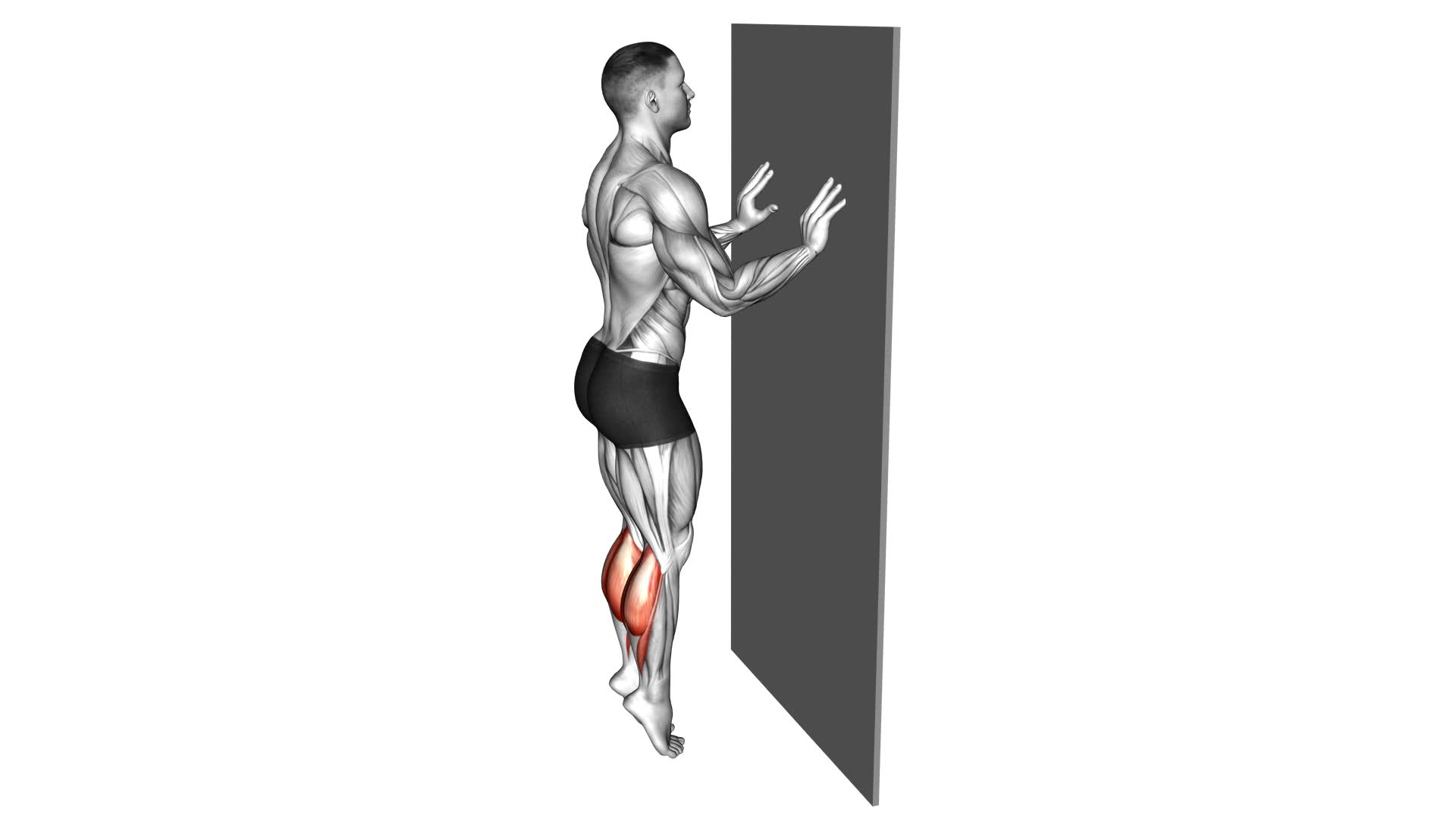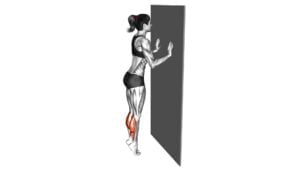Calf Raise With Wall Support – Video Exercise Guide & Tips

In this video exercise guide, you'll learn how to do calf raises with wall support for stronger calves.
Watch This Exercise Video
This exercise helps improve your lower body strength and stability.
You'll discover the proper form and technique to maximize the effectiveness of your calf raises.
Plus, we'll share tips to increase the intensity of the exercise.
Avoid common mistakes and explore variations and progressions to challenge yourself further.
Get ready to elevate your calf workout with this informative and instructional video guide.
Key Takeaways
- Calf raises with wall support improve ankle stability.
- They strengthen the lower legs, targeting the calf and ankle muscles.
- Calf raises can be done conveniently anywhere.
- Proper form and technique are essential for effective calf raises.
Benefits of Calf Raises With Wall Support
You can experience several benefits by incorporating calf raises with wall support into your workout routine. This exercise is particularly effective for improving ankle stability and strengthening the lower legs. By performing calf raises with wall support, you can target the muscles in your calves and ankles, helping to increase their strength and stability.
One of the key benefits of this exercise is improved ankle stability. Calf raises with wall support require you to balance on the balls of your feet while keeping your heels off the ground. This helps to strengthen the muscles surrounding the ankle joint, making it more stable and less prone to injuries.
Additionally, calf raises with wall support are great for strengthening the lower legs. The muscles in your calves, including the gastrocnemius and soleus, are primarily targeted during this exercise. By regularly incorporating calf raises with wall support into your routine, you can increase the strength and size of these muscles, leading to improved overall lower leg strength.
To perform calf raises with wall support, stand facing a wall with your hands resting lightly against it. Lift your heels off the ground as high as you can, then slowly lower them back down. Repeat this movement for a desired number of repetitions.
Proper Form and Technique for Calf Raises
To ensure proper form and technique for calf raises with wall support, it's important to focus on maintaining a stable and balanced position throughout the exercise. This will help you effectively target your calf muscles and avoid any unnecessary strain or injury.
First, stand facing a wall with your feet hip-width apart and your hands resting lightly against the wall for support. Keep your back straight and engage your core muscles to maintain stability.
To perform the calf raise, slowly raise your heels off the ground, lifting your body weight onto the balls of your feet. Pause for a moment at the top of the movement, then slowly lower your heels back down to the starting position.
It is crucial to keep your movements controlled and avoid any bouncing or jerking motions. Focus on squeezing your calf muscles as you lift your heels and maintain a steady pace throughout the exercise.
For added challenge and variety, you can try different calf raise variations such as single-leg calf raises or seated calf raises. These variations target your calf muscles from different angles and can help to further strengthen and tone them.
No special equipment is needed for calf raises with wall support, making them a convenient exercise that can be done anywhere. Just find a wall or sturdy surface for support, and you're ready to go. Remember to always listen to your body and adjust the intensity of the exercise as needed.
Tips to Increase Intensity and Effectiveness
To increase the intensity and effectiveness of calf raises with wall support, incorporate the use of weights or resistance bands. Adding weights will provide additional resistance and help to challenge your calf muscles even more. You can hold dumbbells in each hand or use a weighted vest to increase the load on your calves. Another option is to use resistance bands, which can be wrapped around the balls of your feet and held in your hands for added resistance.
In addition to using weights or resistance bands, you can also modify calf raises by changing the tempo of the exercise. Slow down the movement by taking three seconds to raise your heels and three seconds to lower them back down. This will increase the time under tension and make the exercise more challenging.
To incorporate calf raises into your workout routine, you can perform them as part of a lower body or full body workout. They can be done at the beginning of your workout to activate the calf muscles or at the end as a finisher. Aim to perform 2-3 sets of 12-15 repetitions, gradually increasing the weight or resistance as you get stronger.
By incorporating weights or resistance bands and modifying the tempo of the exercise, you can increase the intensity and effectiveness of calf raises.
Now let's move on to the next section and discuss common mistakes to avoid during calf raises.
Common Mistakes to Avoid During Calf Raises
To optimize your calf raise with wall support, it's crucial to avoid common mistakes that can hinder your progress and effectiveness. One of the most common mistakes isn't maintaining proper form throughout the exercise. It's important to keep your back straight, shoulders relaxed, and core engaged. Avoid leaning forward or backward, as this can put unnecessary strain on your lower back and reduce the effectiveness of the exercise.
Another common mistake is using momentum to lift your body up instead of relying on the strength of your calf muscles. Remember to control the movement and focus on squeezing your calf muscles at the top of the exercise. This will ensure that you're getting the most out of each repetition.
It's also important to avoid locking your knees at the top of the movement. Keep a slight bend in your knees to maintain tension in your calf muscles throughout the exercise.
Lastly, don't neglect your breathing. Many people forget to breathe properly during calf raises, which can lead to dizziness or lightheadedness. Inhale as you lower your heels and exhale as you raise them.
Variations and Progressions for Calf Raises
Try incorporating different variations and progressions to challenge your calf muscles and enhance your calf raise with wall support exercise.
There are several calf raise modifications that can help you target different areas of your calves and increase the difficulty of the exercise.
One variation is the single-leg calf raise, where you perform the exercise with one leg at a time. This requires more balance and stability, engaging your calf muscles even more.
Another modification is the seated calf raise, which can be done using a calf raise machine or a weighted barbell across your thighs. This variation focuses on the soleus muscle, located deeper in the calf.
If you're looking for more advanced calf raise techniques, you can try the explosive calf raise. This involves quickly pushing off the ground and jumping as high as you can during the calf raise motion. This adds plyometric training to your calf workout, increasing power and explosiveness.
Another advanced technique is the donkey calf raise, where you position yourself on a raised surface and have a partner sit on your lower back. This increases the resistance and challenges your calf muscles even more.
Remember to start with the basic calf raise with wall support exercise and gradually incorporate these variations and progressions as you become stronger and more comfortable. Always listen to your body and adjust the difficulty level according to your fitness level.
Frequently Asked Questions
How Many Sets and Reps Should I Do for Calf Raises With Wall Support?
To progress in calf raises with wall support, start with 2 sets of 10 reps. As you get stronger, gradually increase the number of sets and reps. Aim for 3 sets of 12-15 reps to challenge your calf muscles.
Can Calf Raises With Wall Support Help Improve My Balance?
Calf raises with wall support can definitely help improve your balance. By incorporating calf raise variations into your workout routine, you can challenge your balance in different ways and enhance your overall stability.
Whether you're a beginner or advanced, adding calf raises to a full body balance workout can be highly beneficial. They target the muscles in your lower legs, which play a crucial role in maintaining balance.
Is It Necessary to Use a Wall for Support While Doing Calf Raises?
If you're wondering if it's necessary to use a wall for support while doing calf raises, the answer is no. There are alternative calf raise variations that don't require a wall.
However, using a wall can provide stability and help you maintain proper form, especially if you're a beginner or have balance issues.
Incorporating calf raises into your workout routine offers benefits like strengthening your calf muscles, improving balance, and enhancing overall lower body strength.
Can Calf Raises With Wall Support Help Prevent Shin Splints?
Calf raises with wall support can be effective in preventing shin splints. By using the wall for support, you can maintain proper form and minimize stress on your shins. This exercise specifically targets the calf muscles, which helps to strengthen and stabilize the lower leg.
While there are other exercises that can also help prevent shin splints, such as toe raises and ankle dorsiflexion exercises, calf raises with wall support offer a simple and convenient option for strengthening your calves and preventing shin splints.
Are There Any Modifications for People With Knee or Ankle Injuries When Performing Calf Raises With Wall Support?
If you have knee or ankle injuries and want to do calf raises with wall support, there are modifications you can try.
Instead of using your injured leg, focus on the other leg to avoid putting too much strain on the injured area.
You can also try seated calf raises or using a resistance band to work your calf muscles without putting pressure on your knees or ankles.
Remember to consult with a healthcare professional before attempting any exercises if you have an injury.
Conclusion
Incorporating calf raises with wall support into your workout routine can provide numerous benefits, including strengthening your calves and improving your balance. By following proper form and technique, you can maximize the effectiveness of this exercise.
Remember to start with a comfortable number of repetitions and gradually increase the intensity as you become stronger. Avoid common mistakes such as using momentum or neglecting the full range of motion.
Finally, consider trying variations and progressions to challenge your muscles even further.

Author
Years ago, the spark of my life’s passion ignited in my mind the moment I stepped into the local gym for the first time. The inaugural bead of perspiration, the initial endeavor, the very first surge of endorphins, and a sense of pride that washed over me post-workout marked the beginning of my deep-seated interest in strength sports, fitness, and sports nutrition. This very curiosity blossomed rapidly into a profound fascination, propelling me to earn a Master’s degree in Physical Education from the Academy of Physical Education in Krakow, followed by a Sports Manager diploma from the Jagiellonian University. My journey of growth led me to gain more specialized qualifications, such as being a certified personal trainer with a focus on sports dietetics, a lifeguard, and an instructor for wellness and corrective gymnastics. Theoretical knowledge paired seamlessly with practical experience, reinforcing my belief that the transformation of individuals under my guidance was also a reflection of my personal growth. This belief holds true even today. Each day, I strive to push the boundaries and explore new realms. These realms gently elevate me to greater heights. The unique combination of passion for my field and the continuous quest for growth fuels my drive to break new ground.







